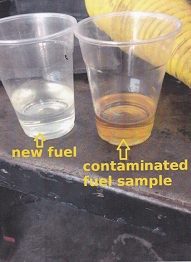The insured’s son was driving the family Kia when the engine quit running and would not restart. It was towed to the dealership. The dealership said that one of the pistons melted and a connecting rod broke. The insured said that there was a fire internally in the engine and the claim should be paid as a fire loss, not denied as an engine failure. Our assignment was to inspect and photograph the vehicle to identify any recalls or manufacturing, mechanical, or service defects or failures that could have caused or contributed to the engine damage. Was the fire the cause of the engine damage, or was there a fire as a result of the engine damage?
Before we inspected the vehicle we researched recalls. None were found that pertained to this particular year, make, and model. In addition, no complaints were found that pertained to this type of engine failure.
When we inspected the Kia at the dealership, the vehicle’s damaged engine had already been replaced. The damaged engine was available for inspection and had no external signs of damage. Broken parts that were found in the engine’s oil pan when the pan was removed were displayed. The mechanics took a photograph of a sample of contaminated fuel that they removed from the gas tank, but then discarded the actual fuel sample, so no lab tests on the fuel were possible.
The engine had a broken connecting rod and broken piston, as well as badly worn bearings. The cause of this catastrophic engine failure was as follows:
· Contaminated fuel deteriorated the seals of the fuel injectors.
· The deteriorated seals caused the fuel injectors to stick in the open position.
· This allowed an abnormal amount of fuel to enter the combustion chamber.
· This extra fuel leaked past the piston rings into the engine’s crankcase.
· The extra fuel then diluted the engine oil in the crankcase.
· The diluted engine oil become extremely thin and lost most of its lubricating properties.
· This resulted in excessive wear to the connecting rod bearings.
· The excessive wear caused an out of tolerance clearance between the connecting rod bearing and the crankshaft.
· As the engine continued to run, this abnormal amount of rod bearing to crankshaft clearance continued to increase and the connecting rod finally broke causing damage to the piston.
· At this point the engine ceased to operate.
The first possible cause of contaminated fuel would be from a purchase of fuel at a refueling station. This appears to be unlikely since the photograph of the contaminated fuel appeared orange in color.

Most, if not all, automotive fuels including methanol and diesel are clear or colorless. The second possibility was vandalism. Since a fuel sample was not retained for laboratory analysis, the chemical or chemicals that caused the fuel injector seal failures are unknown. No evidence was found that would indicate that the engine damage was caused from anything other than the operation of the engine with contaminated fuel which wore the fuel injector seals, diluted the engine oil, wore out the bearings, and ultimately broke the connecting rod.


